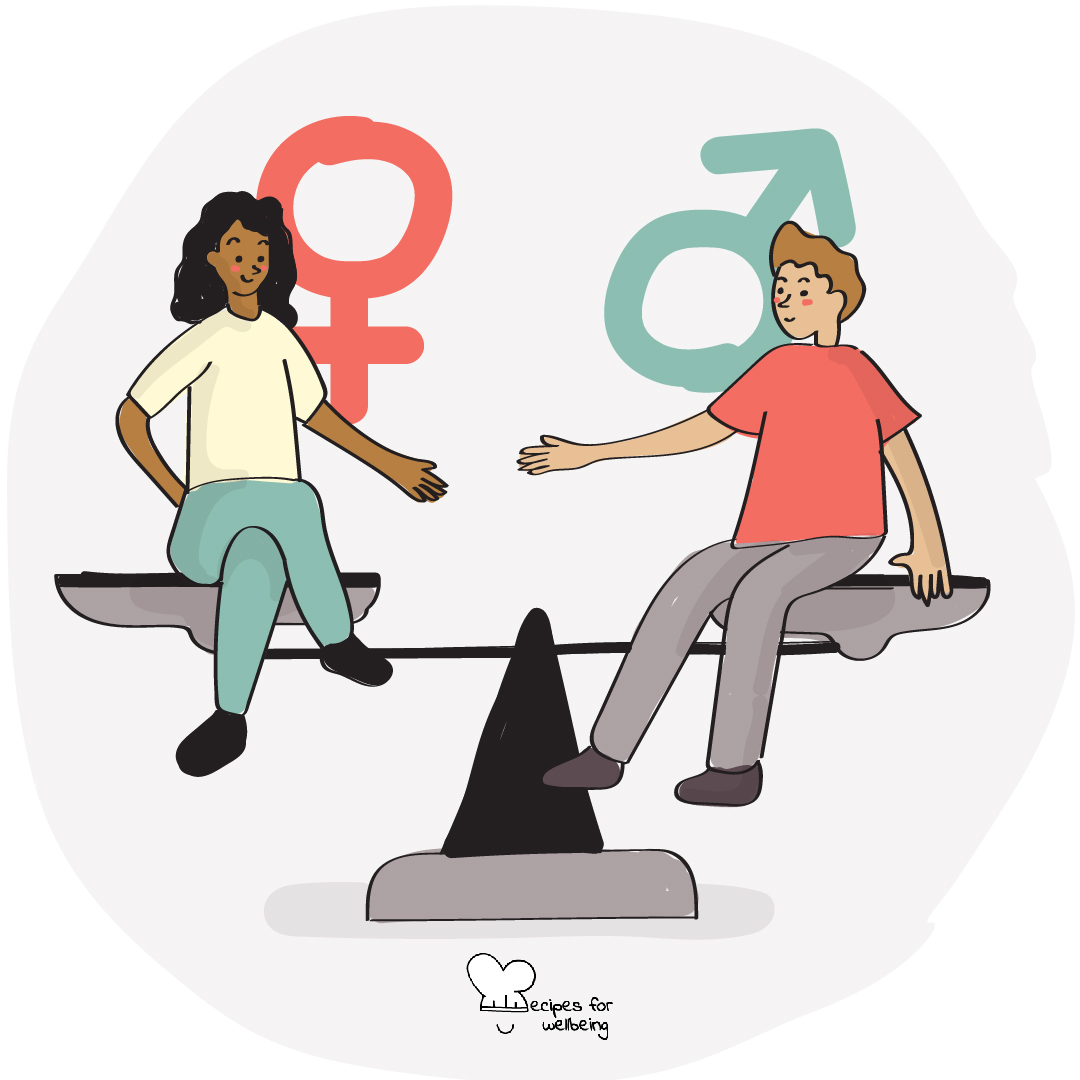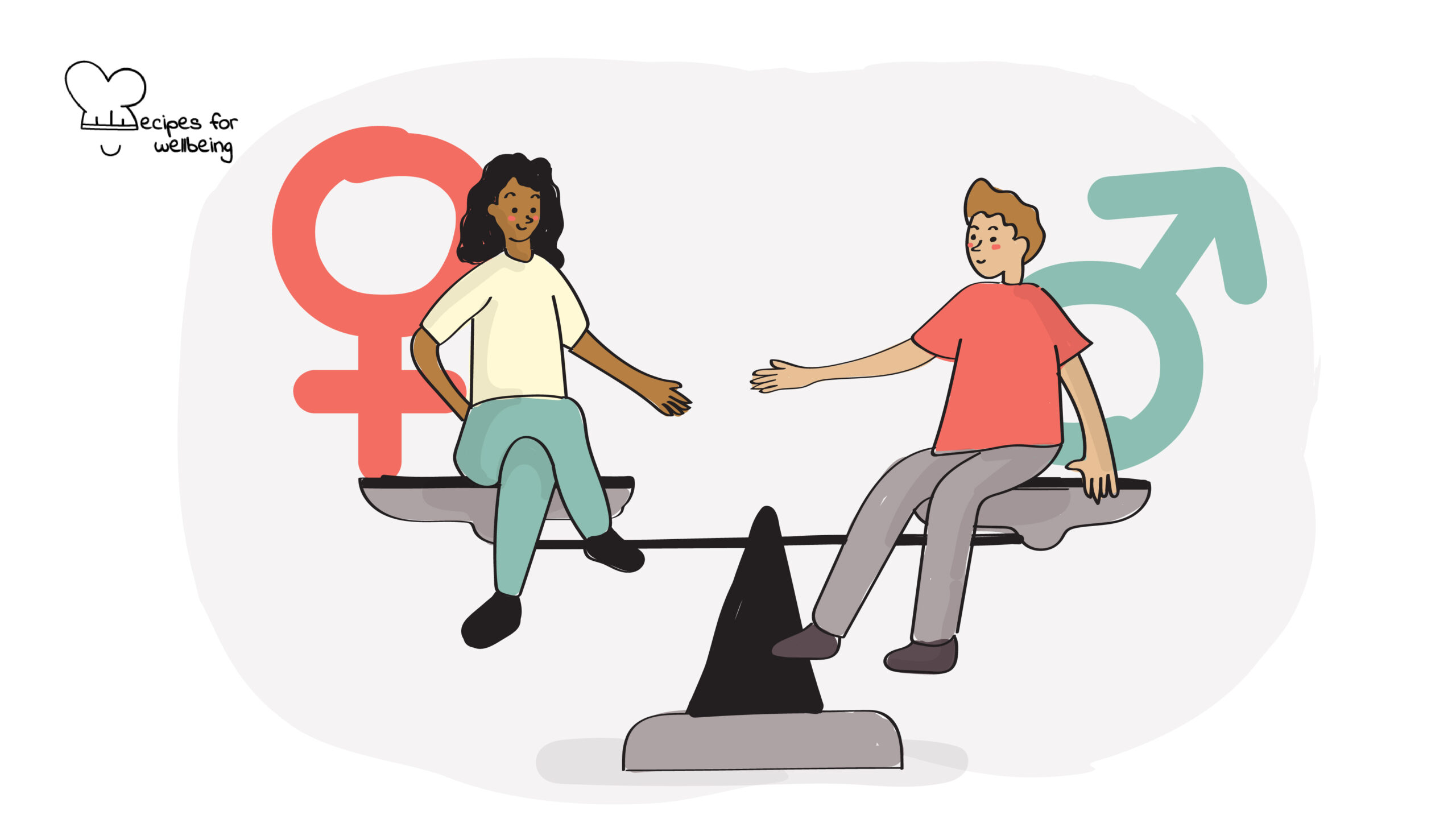
Gender equality through a norm-critical workplace
They say time changes things, but you actually have to change them yourself. ―Andy Warhol
👥 Serves: 11-25 people, 2-10 people, 26-40 people, 41+ people
🎚 Difficulty: Hard
⏳ Total time: 61-120 minutes
🥣 Ingredients: Pens (1 per participant), sheets of paper (1 per participant), a space in which people can move around a bit, openness to feeling uncomfortable and uneasy in the process
🤓 Wholebeing Domains: Community, Liberatory Learning, Radical Care
💪 Wholebeing Skills: Acknowledgement, Allyship, Challenging, Hosting conversations, Liberation, Multiperspectivity, Reflection, Relating to Others, Self-directed learning

Gender equality through a norm-critical workplace
📝 Description
Cultivating gender equality in the workplace.
Workplaces are often permeated by inequalities based on gender, race, sexuality, and many other aspects. Many of those inequalities often remain invisible, especially to those who are not directly affected by these forms of discrimination. But everyone in the organisation has a responsibility to create and foster organisational wellbeing. This recipe provides an approach to rethink equality and fairness in the workplace to create gender equality and fight sexist biases in organisations. The tools presented can also be used to address other forms of discrimination.
The activity provides norm-critical insights on how the formulation of our identity in itself can reinforce certain organisational norms and biassed practices. The aim is to visualise intersecting identity categories and transgress them, in order to acknowledge the difference without having it fixed as such. It is meant to make unmarked categories of power and privilege visible. It also aims at discussing intersectionality/intersectional identities with organisational and societal norms as points of reference. Participants are encouraged to critically reflect on dominant norms and how some of these can be needlessly exclusionary to some people who do not ‘fit’ or perform the idealised norms.
This recipe has been created out of GenderLAB, an innovative and co-creative workshop format created by Copenhagen Business School’s Diversity and Difference Platform and KVINFO in cooperation with Hanken School of Economics, the GODESS Institute and KTH Royal Institute of Technology.
👣 Steps
Step 1 – Preparation (5’)
Gather your participants and hand them a sheet of paper and a pen each. If you are more than 8, divide the group into subgroups of maximum 8 people and ensure each group has a facilitator.
Step 2 – Draw a hand (5’)
All participants take a sheet of paper on which they trace the outline of one of their hands. They are asked to write their own name in the centre of the hand.
Step 3 – Explor self-identities (5’–10’)
Participants now come up with five (self-identified) categories that represent an attribute or aspect of their identity. They should select their identities based on how they see themselves and not how others might see them. It will be voluntarily what they choose to share, wherefore this should not influence their decision which categories to choose. Participants write one category on each of their outlined fingers. (Categories can for example be their gender, ethnicity, nationality, sexuality, class, age, etc. but also family role – e.g. being a mother/father, their occupation/job, etc. To avoid influencing the categories participants choose, try to avoid giving examples but rather stress that they are free to choose any category they believe describes them.)
Step 4 – Introduce each other (20’)
Participants in each group are now invited to introduce themselves based on the five categories they have chosen. They are also asked to reflect on why they chose the category and what was hard or easy about making these choices. Next, the facilitator asks participants which of the categories would have changed if they had been asked not to self-identify but choose categories depending on how others see them. There are two main aims of this conversation: (1) to discuss how we easily box other people into categories according to their gender, race, sexuality, etc. while we might not want to necessarily self-identify with these same categories, (2) to realise that categories that seem deviant to the norm are more often mentioned as identifying a person than normative categories. For example, it is likely that women will more often mention their gender than men due to the experience of being recognised as a woman in the workplace, black people and people of colour will more often mention their race/ethnicity than white people due to the experience of being recognised as black/person of colour in the workplace. This is due to particular norms permeating in our societies and organisations that reproduce biases and inequalities by making some people seem ‘in the right place’ while others seem ‘out of place’. Only by becoming aware and critical of these norms can we fight the inequalities they produce. This will become clearer in the next step.
Step 5 – Debunk stereotypes (10’)
Out of the five identities, participants now choose two. For each identity, they form a sentence based on a stereotype that they have heard about and that fails to fully/accurately describe them as an individual. Participants write these two sentences down, phrasing them in the form of “I am a/an …, but I am not…”. (Example: I am a woman, but I am not weak. I am a manager, but not a middle-aged white man. I am a wife, but I do not have a husband.)
Step 6 – Discuss in pairs (20’)
Participants are paired up (if you are an uneven number, a group of three people works equally well). Everybody chooses one of the stereotypes (I am / I am not) they have written down and discusses the following questions with their exercise partner: “How did it affect you to be boxed into a stereotype? What normative ideas do you think this stereotype is based upon? Have you ever boxed in someone else and how do you think it affected them? What could you have done differently?”
Step 7 – Debrief (30’)
As a final step, there is a group debrief (if you have split up into sub-groups, you come back together for this final part). In the group, participants are encouraged to share what they learned during the activity. They are also asked how they have felt throughout and feel now. It is important to acknowledge that it can be very uncomfortable to discuss inequalities and biases, but that this does not mean that we should turn away from these conversations. Instead, activities like this one provide an initiation to share the uncomfortableness and take them as a starting point towards taking action. Before you close the activity, ask each participant to write down three things they will do – (1) today, (2) this week, (3) this month – to start changing the inequalities they have become aware of today. These can be small steps, but they can initiate important change.
Step 8 – Take it further – optional (30’)
(Optional) If you wish to take further steps towards action, you can add a final exercise in which you ask participants to write down the ideas that they came up with as part of step 6 to the question “What could you have done differently?”. While these replies will most likely be individual ideas, ask them to translate them to organisational ones, asking “What can we as an organisation do to foster inequality and create a norm-critical workplace?” For even more guidance towards how to create organisational change, take a look at the full GenderLAB format and find out how your organisation can benefit from hosting a full GenderLAB.

